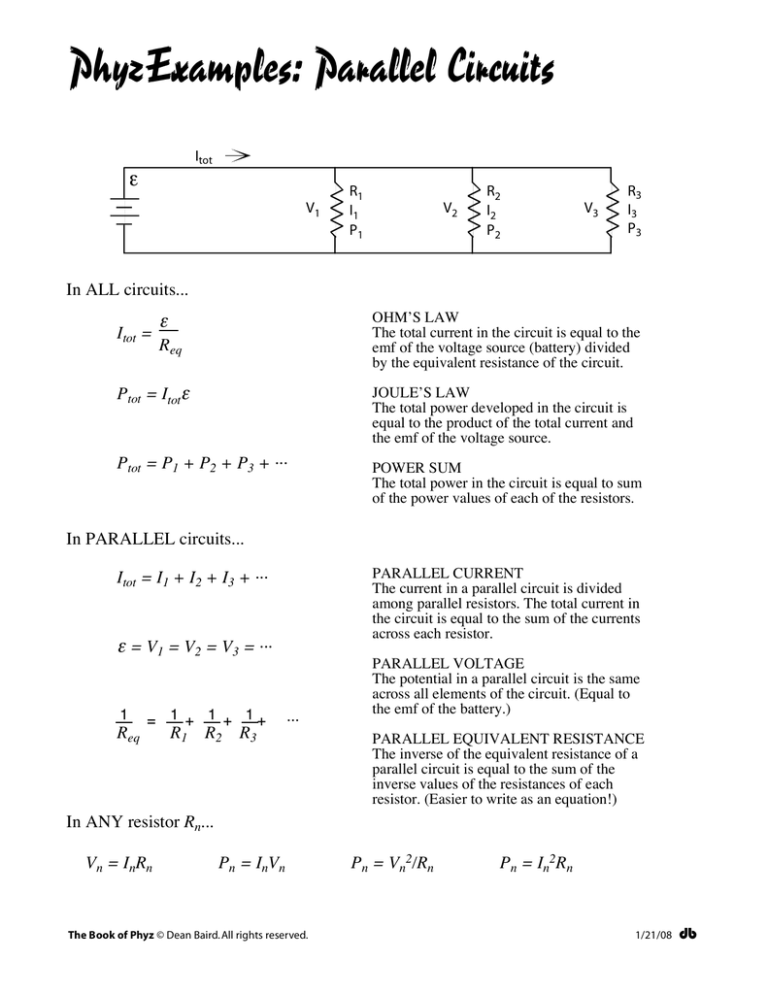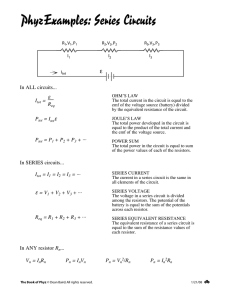
PhyzExamples: Parallel Circuits
Itot
ε
V1
R1
I1
P1
V2
R2
I2
P2
V3
R3
I3
P3
In ALL circuits...
Itot =
OHM’S LAW
The total current in the circuit is equal to the
emf of the voltage source (battery) divided
by the equivalent resistance of the circuit.
ε
Req
Ptot = Itotε
JOULE’S LAW
The total power developed in the circuit is
equal to the product of the total current and
the emf of the voltage source.
Ptot = P1 + P2 + P3 + ···
POWER SUM
The total power in the circuit is equal to sum
of the power values of each of the resistors.
In PARALLEL circuits...
PARALLEL CURRENT
The current in a parallel circuit is divided
among parallel resistors. The total current in
the circuit is equal to the sum of the currents
across each resistor.
Itot = I1 + I2 + I3 + ···
ε = V1 = V2 = V3 = ···
1
Req
= 1 + 1 + 1+
R1
R2
R3
···
PARALLEL VOLTAGE
The potential in a parallel circuit is the same
across all elements of the circuit. (Equal to
the emf of the battery.)
PARALLEL EQUIVALENT RESISTANCE
The inverse of the equivalent resistance of a
parallel circuit is equal to the sum of the
inverse values of the resistances of each
resistor. (Easier to write as an equation!)
In ANY resistor Rn...
Vn = InRn
Pn = InVn
The Book of Phyz © Dean Baird. All rights reserved.
Pn = Vn2/Rn
Pn = In2Rn
1/21/08
db
20 A
40 V
5
300 W
Given this information, what can be determined about the circuit? EVERYTHING!!!
1. Since the potential in the circuit is 40 V (same across all resistors in parallel) and the total
current in the circuit is 20 A, the equivalent resistance in the circuit is
Req = ε/I = 40 V / 20 A = 2 Ω
2. Since R2 = 5 Ω and V = 40 V, the current through R2 is
I2 = V/R2 = 40 V / 5 Ω = 8 A
3. The power dissipated in R2 is
P2 = V2/R2 = (40 V)2 / 5 Ω = 320 W
4. Since the power dissipated in R3 is 300 W, the current through R3 is
I3 = P3/V = 300 W / 40 V = 7.5 A
5. And the resistance of R3 is
R3 = V2/P = (40 V)2 / 300 W= 5.3 Ω
6. Since the equivalent resistance of the circuit is 2 Ω, R2 is 5 Ω, and R3 is 5.3 Ω, R1 can be
found:
1/R1 = 1/Req – 1/R2 – 1/ R3 = 1 / 2 Ω – 1 / 5 Ω – 1 / 5.3 Ω
thus R1 = 8.9 Ω
7. The current through R1 is
I1 = Itot – I2 – I3 = 20 A – 8 A – 7.5 A = 4.5 A
or
I1 = V/R1 = 40 V / 8.9 Ω = 4.5 A
8. And so the power dissipated in R1 is
P1 = V2 / R1 = (40 V)2 / 8.9 Ω = 180 W
9. So the total power dissipated in the circuit is
Ptot = P1 + P2 + P3 = 180 W + 320 W + 300 W = 800 W
or
Ptot = Iε = 20 A · 40 V = 800 W
The Book of Phyz © Dean Baird. All rights reserved.
1/21/08
db




